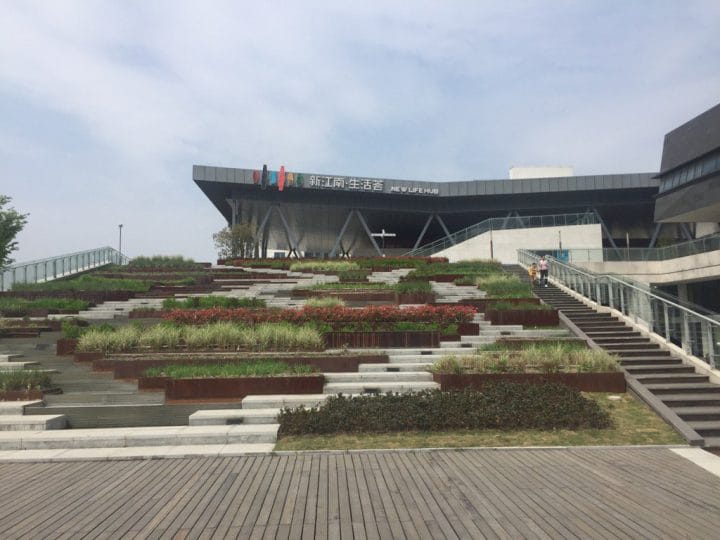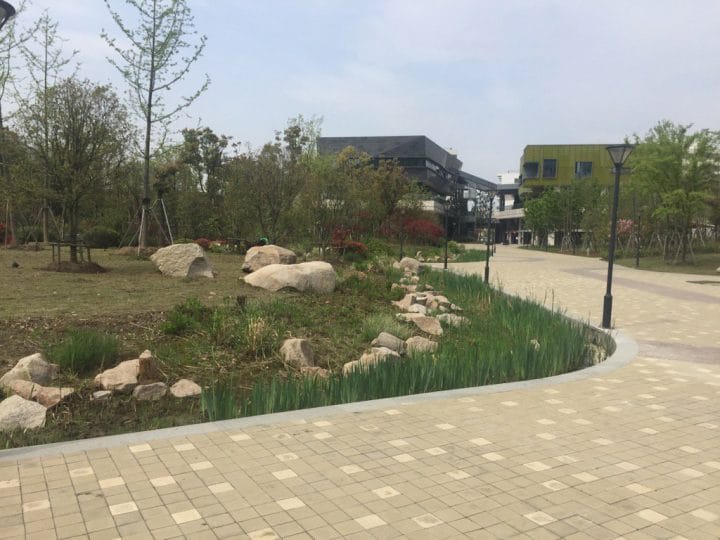Water Sensitive Steps a highlight of Kunshan’s progress
Rome may be famous for their Spanish Steps but the City of Kunshan in China is drawing visitors of an environmental persuasion with its Water Sensitive Steps.
This remarkable feature, which uses appealing native plants and grasses to trap and filter rainwater and stormwater, is one of many water sensitive sites being developed across the eastern Chinese city with input from the CRC for Water Sensitive Cities (CRCWSC).
Kunshan, a city of more than 1.6 million near Shanghai, has been awarded the title of National Ecological Garden City but still faces many of the same issues as other growing Chinese, and arguably of cities around the world, including water infrastructure that is over capacity or affected by pollution and flooding. The landscape in and around Kunshan is a polder, a low-lying tract of land enclosed by dikes with no connection to outside water other than through features such as canals or diverted rivers.

Methods used by Chinese governments and water authorities to deal with flooding and related issues are being passed on to the Australian water industry through tours such as the recent Australia Week in China business mission conducted by Austrade.
The Urban Sustainability and Water Management tour, from 11-15 April, provided CRCWSC participants including GHD, SPEL Environmental and Water Technology with the chance to view water sensitive urban design features in several Chinese cities. The trip also allowed CRCWSC Chief Executive Professor Tony Wong and International Engagement Manager (Asia) Jianbin Wang to catch up on the progress on ongoing collaborative projects.
The pair were pleased to note that Kunshan, CRCWSC’s first China-based ‘incubator city’, has this month introduced an incentive scheme to foster the implementation of water sensitive practices in private sector development. The scheme also gives developers an effective increase in permissible building footprint by recognising green roof and vegetated cover as part of the total green space area if the development parcel satisfies Kunshan local ‘sponge city’ requirements.
Zhou Jichun, Director of the Kunshan Bureau of Housing and Urban-Rural Development, estimates the initiative will cost the city approximately ¥20million (AUD$4milllion) annually but will yield benefits many times this.
“Being a polder city, we find our stormwater pipes constantly silted and requiring dedicated maintenance to ensure the city is adequately protected from (pluvial) flooding. Introduction of green infrastructure to buffer and cleanse the water quality in the many kilometres of canals within our city will significantly reduce our maintenance burden while improving the environmental quality of the city,” said Director Zhou.
Tony said the recent tour helped reinforce ongoing partnerships with Chinese government and industry organisations and expose Australian partners to new business opportunities in the region.
“The CRCWSC worked with Austrade in developing the itinerary and we hope our presentation will help pave the way to introduce Australian expertise in water sensitive urban design and how they could assist Chinese sponge cities to deliver their programs,” Tony said.
“The CRCWSC will over the next 18 months be actively working to establish pathways to market in China for our participants as Tranche 1 research outputs become widely available for adaption and adoption.”

The Kunshan projects have been informed by the successful Kunshan Studio, where architectural design researchers and students developed concept designs as part of the project Urban intensification & green infrastructure: Towards a water sensitive city (Project D5.1).
CRCWSC researchers developed the water management strategy and concept design in 2014 for the wetland project contained in a business park (pictured above). The project involved working closely with China-based SME Associate Partner Integrated Planning and Design to integrate the concept into the landscape design with site inspections during construction stage. The project was successfully completed in 2015.

CRCWSC research has also been utilised in introducing Chinese government officials to biosponges, which have been implemented in pilot ‘sponge cities’ of Xiamen (Fujian Province) and Jiaxing (Zhejiang Province). Biosponges have previously been applied in Australian-based CRCWSC research projects, such as the award-winning Gum Scrub Creek at Officer in Victoria, as part of Integration and demonstration through urban design (Project D1.1). The demonstration project incorporated several biosponges developed by the CRCWSC to protect and enhance the ecological values of the waterway as urban development occurred within the catchment.
The strong CRCWSC presence in China will continue next at the International Low Impact Development (LID) Conference in Beijing in June. More than 20 presentations are expected to be delivered by CRCWSC researchers, representing the largest contribution to the conference from a single organisation.